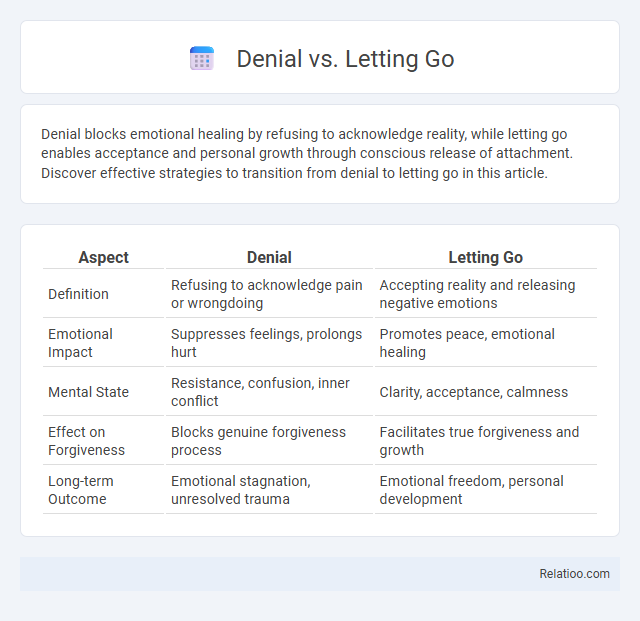Denial blocks emotional healing by refusing to acknowledge reality, while letting go enables acceptance and personal growth through conscious release of attachment. Discover effective strategies to transition from denial to letting go in this article.
Table of Comparison
| Aspect | Denial | Letting Go |
|---|---|---|
| Definition | Refusing to acknowledge pain or wrongdoing | Accepting reality and releasing negative emotions |
| Emotional Impact | Suppresses feelings, prolongs hurt | Promotes peace, emotional healing |
| Mental State | Resistance, confusion, inner conflict | Clarity, acceptance, calmness |
| Effect on Forgiveness | Blocks genuine forgiveness process | Facilitates true forgiveness and growth |
| Long-term Outcome | Emotional stagnation, unresolved trauma | Emotional freedom, personal development |
Understanding Denial: A Psychological Overview
Denial is a psychological defense mechanism where Your mind unconsciously rejects reality to protect against painful emotions or facts, often leading to prolonged distress. Letting go involves accepting reality and releasing emotional attachment, promoting healing and mental clarity. Understanding denial helps distinguish it from healthy acceptance, enabling better emotional management and personal growth.
The Nature of Letting Go: What It Really Means
Letting go involves consciously releasing attachment to negative emotions, enabling emotional healing and personal growth, unlike denial which suppresses or ignores reality. You achieve emotional clarity and resilience by accepting situations as they are, rather than resisting or rejecting them. This process fosters true acceptance, encouraging mindfulness and inner peace.
Key Differences Between Denial and Letting Go
Denial involves refusing to accept reality or facts, often leading to emotional resistance and prolonged suffering, whereas letting go means consciously accepting a situation and releasing attachments to find peace. Your ability to recognize and differentiate these processes allows for healthier emotional well-being and personal growth. Key differences include denial's focus on avoidance and defense mechanisms, while letting go emphasizes acceptance and mindful surrender.
Emotional Impacts: Denial vs Letting Go
Denial often intensifies emotional distress by prolonging avoidance of painful truths, leading to increased anxiety and unresolved grief. Letting go facilitates emotional healing by accepting reality, reducing mental burdens, and promoting psychological resilience. The contrast in emotional impact highlights denial as a barrier to recovery, whereas letting go fosters peace and adaptive coping mechanisms.
Signs You’re in Denial
Signs you're in denial include refusing to acknowledge painful realities, minimizing the impact of events, and consistently blaming external factors for personal challenges. Individuals often experience emotional numbness, avoid discussing the issue, and demonstrate defensive behavior when confronted with facts. Persistent avoidance of solutions and an inability to accept change highlight the difference between denial and the healthier process of letting go.
Recognizing When You’re Ready to Let Go
Recognizing when you're ready to let go involves distinguishing between denial and acceptance, as denial often masks unresolved emotions and hinders healing. Letting go requires conscious acknowledgment of reality and emotional readiness to release attachment to past pain or unmet expectations. Your growth depends on identifying these signs of readiness, such as decreased emotional reactivity and increased clarity about moving forward.
The Role of Acceptance in Letting Go
Acceptance plays a crucial role in the process of letting go by allowing you to acknowledge reality without resistance or denial. Unlike denial, which involves rejecting or ignoring painful truths, acceptance fosters emotional healing and clarity. Embracing acceptance facilitates genuine release, enabling personal growth and inner peace.
Why Denial Persists: Root Causes and Triggers
Denial persists due to deep-rooted psychological defense mechanisms that protect individuals from confronting painful realities, often triggered by traumatic events, fear of loss, or overwhelming stress. This persistent denial is reinforced by cognitive biases such as confirmation bias and selective attention, which distort perception and delay acceptance. Understanding these root causes and triggers is crucial for effectively transitioning from denial to letting go, enabling emotional healing and adaptive coping.
Steps to Move from Denial to Letting Go
Steps to move from denial to letting go involve first acknowledging the reality of the situation and emotions without resistance, which helps break the initial barrier of refusal. Next, practicing mindfulness and self-reflection deepens understanding and acceptance of the loss or change. Finally, engaging in supportive activities such as therapy, journaling, or support groups facilitates emotional release and fosters resilience necessary for genuine letting go.
Benefits of Letting Go for Mental Health
Letting go promotes emotional resilience by reducing stress and anxiety, allowing the mind to heal from past trauma and negative experiences. Unlike denial, which often prolongs suffering by avoiding reality, letting go fosters acceptance and mental clarity, improving overall psychological well-being. Embracing this process enhances mindfulness and supports healthier coping mechanisms, crucial for sustained mental health.

Infographic: Denial vs Letting Go
 relatioo.com
relatioo.com